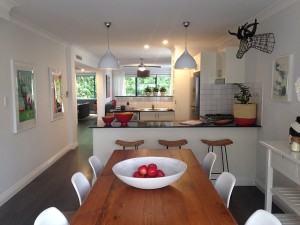 Due to the difficulty and cost of re-wiring your [city] home (which can be impossible if you’re only renting), lighting often takes the least priority in a home decorating plan. But the truth is that poor lighting can make any living space decked out with expensive décor look drab and uncomfortable.
Due to the difficulty and cost of re-wiring your [city] home (which can be impossible if you’re only renting), lighting often takes the least priority in a home decorating plan. But the truth is that poor lighting can make any living space decked out with expensive décor look drab and uncomfortable.
It helps to think of lighting as jewelry for your home’s living spaces, having the ability to give it some personality and sparkle. So, sit down and be ready to take down some of these lighting design tips from professional interior designers.
1. Living Spaces in Layers
Layering your lighting refers to the method of using several light sources in a single space, guaranteeing your home is well lit and have an atmosphere, depending on the type or combination of lighting used. At its most basic, light layering involves three components:
- Ambient lighting or general lighting – refers to the room’s main light source, usually producing an even spread of illumination
- Task lighting – Lighting for specific tasks (reading, cooking, safety)
- Accent lighting – Decorative lighting that adds interest to decorative pieces and areas
2. Use Pendant Lights
The beauty of pendant lights lies in their flexibility. Several pendants can be used as general lighting, while one or two pendants can be installed over a reading nook or kitchen island as task lights. Whether you install them at equal distances from each other, or in a cluster at varying elevations, pendant lights—especially when outfitted with LED light bulbs—can generate enough light to maximize safety and create a pleasant atmosphere.
3. Use a Dimmer
Use a dimming controller to control your lights’ brightness. Dim the lights for a softer mood, such as when entertaining guests, or increase the brightness when doing work, such as cooking or homework. Note that not all kinds of light bulbs work well with dimmers—to be safe, use dimmer-compatible LED light bulbs.
4. Install Even Lighting Near Mirrors
Have you ever wondered why you sometimes look better in front of a hotel mirror than the one you have at home? The reason has to do with light. To avoid unflattering shadows and ensure your face is fully illuminated when looking at a mirror (whether you’re brushing your teeth, shaving, or applying makeup), install a fixture that’s at least 24 inches wide over the mirror, as well as two sconces or pendant on either side.
5. Don’t’ Be Afraid to Experiment
Don’t be afraid to use certain fixtures in unexpected spaces. For example, chandeliers are often installed in living rooms, but that doesn’t you can’t use them in the master bedroom, dining room, or even the bathroom. The unexpected dash of elegant will be a pleasant surprise.
6. Bring In the Light
Artificial lights have come a long way, but they still can’t beat the quality and warmth of pure sunlight. Open up your home to natural light by leaving windows unobstructed, or if time and money permit, adding a skylight and a few more windows.

![5 Things First-time LED Buyers Should Know [city]](https://8blocks.s3.amazonaws.com/eepros/blog-images/2014/06/roi-bulbs-300x225.jpg)
![6 Great Ways to Illuminate Your [city] Home’s Bathroom with LEDs [city]](https://eepros.com/wp-content/uploads/2017/06/bathroom-2094733_640-300x200.jpg)
![Transform Your Master Bedroom into a Sanctuary With These 7 Lighting Ideas [city]](https://eepros.com/wp-content/uploads/2018/12/wall-416062_640-300x169.jpg)
![LEDs Can Save Millions in [city]. How Much Can They Save You? [city]](https://8blocks.s3.amazonaws.com/eepros/blog-images/2014/08/LED-Bulbs-300x203.jpg)